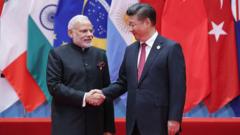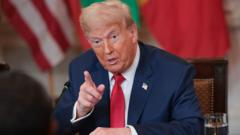After years of strained relations, India and China are cautiously moving towards a diplomatic reset, but significant challenges persist.
Resetting India-China Relations: A Cautious Approach Amidst Tensions

Resetting India-China Relations: A Cautious Approach Amidst Tensions
India seeks a pragmatic reconnection with China as geopolitical shifts shape bilateral ties.
As geopolitical dynamics shift, India is navigating a delicate relationship with China, seeking to mend ties while acknowledging the persistent underlying tensions. The recent visits by senior Indian officials to China signal a thaw in relations, although experts caution that the path forward is fraught with complexity.
In a significant move, Indian National Security Adviser Ajit Doval and Defence Minister Rajnath Singh visited China in June, coinciding with the Shanghai Cooperation Organisation (SCO) meetings—a security alliance that includes major powers like China, Russia, and Pakistan. Singh’s visit marked the first from a senior Indian official in five years, underscoring the urgency of diplomatic engagement following a series of border conflicts that have marred relations.
The core of the India-China discord lies in an ill-defined border that spans 3,440 km (approximately 2,100 miles). The numerous geographical features along the border can introduce ambiguity, leading to confrontations. Tensions peaked in June 2020 with a clash in the Galwan Valley in Ladakh, resulting in the deaths of 20 Indian and four Chinese soldiers—the first fatalities between the two countries since 1975. Since then, several military standoffs have occurred.
Despite these historical grievances, the nations have made tentative progress. Earlier negotiations resulted in agreements addressing primary friction points in Ladakh, while recent talks allowed for the restoration of direct flights and relaxed visa policies for movement between the two nations.
Bilateral trade between India and China surpassed $127 billion last year, making China India’s second-largest trading partner, particularly in imports such as rare earth minerals—essential for various sectors, including technology and manufacturing. Hence, fostering a peaceful border environment is crucial for economic stability.
Political analysts note that as China focuses on Taiwan, it also seeks calm along its southern border with India to facilitate trade and investments. Conversely, China harbors concerns about India’s growing ties with Western governments aimed at counterbalancing its rise. Consequently, Beijing advocates for reduced restrictions and increased cooperation but maintains its territorial claims and tensions regarding regions such as Arunachal Pradesh.
Meanwhile, the United States factors into this delicate balance. Delhi’s relationships with Western allies may not be as solid as anticipated, given recent geopolitical uncertainties, including the increasing military collaboration between China and Pakistan. This backdrop has encouraged India to explore diplomatic dialogue with China, especially amid pressures surrounding trade negotiations.
The unpredictability of U.S. foreign policy underpinned by previous administrations raises doubts in New Delhi about Washington’s commitment to supporting India in the event of renewed tensions with China. The Quadrilateral Security Dialogue, which involves key partners like Japan and Australia, has receded into the background as attention shifts to more pressing issues.
As India observes Russia’s growing affinity for China amid the Ukraine conflict, its assessment of strategic alliances becomes increasingly critical. Rising reliance on China for trade and essential goods makes navigating this relationship complex, particularly as Beijing imposes trade restrictions that threaten India’s economic interests.
Amid these considerations, experts argue that for any sustainable peace to emerge, both India and China must rethink their stances on sovereignty and territorial claims. Nevertheless, it appears both nations are willing to engage in pragmatic cooperation to avert immediate conflicts and work towards shared economic benefits, despite looming uncertainties.


















